My trip on Sunday was supposed to be a snake trip. I have been scouting the ridgeline just north of I-78 at the border of Berks and Schuylkill Counties for rocky outcroppings on south-facing slopes. These are classic timber rattlesnake (Crotalus horridus) den habitat. Timber rattlesnakes hibernate together in cracks and cavities deep in such hillsides. In the spring they tend to hang out around the outcroppings before dispersing. The return in the fall, catch some rays at their den site before things get too cold, and then hibernate.
I have found some great den sites, but I know that not all of them are occupied. Timber rattlesnakes live on this ridgeline, but they are not common, and so the challenge will be figuring out which of the hundreds of potential den sites over a few dozen miles of ridgeline are occupied.
Timber rattlesnake dens are a delicate topic in PA herping. Timber rattlers are rare and, in my opinion as well as that of most herpers I talk to, should be given greater protection than they are currently given under state law. Since rattlers from several square miles hibernate together in communal dens, it is really easy to extirpate them from an area. All one has to do is find the den and show up in the spring or fall with a shotgun or with a few pillowcases and a snake stick. That happens more often than you might think.
So, I was somewhere on that ridgeline (covered by several state game lands and at least one state forest) on Sunday with Scott, who is a third-generation Philly herper who knows the region a lot better than I do. He’s also an intern in emergency medicine, which struck me as a valuable characteristic in a herping companion as I we scrambled over ankle-twisting rocky outcroppings and slopes of loose boulders in search of venomous snakes. We made it out without breaking any limbs, but without finding any snakes either.
The big find was all the action going on at the ridge top. I had found this mountain bog a few weeks ago when it looked like this:
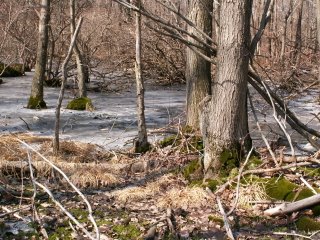
Now it was all thawed out and chock-full of egg masses:

Here are some photos of the largest, likely deposited by wood frogs (Rana sylvatica). It had to be six feet across. I didn’t even spot it at first; for some reason it registered in my brain as moss until Scott shouted and knelt down to take a closer look.
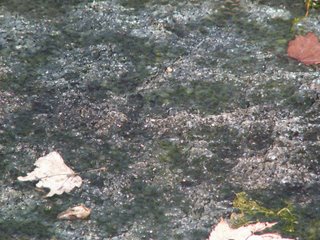

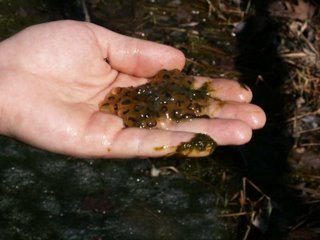
In this pond next to the bog, we found more egg masses, likely of spotted salamanders (Ambystoma maculatum), as well as some adult frogs we didn’t see well enough to identify, the head of a turtle we likewise could not identify, and a small army of newts (Nopthalmus viridiscens viridiscens) cavorting around the leaves at the bottom.
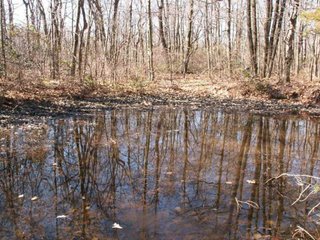
Newts love to eat the egg masses of other amphibians. Here is a photo of one of them in the water:
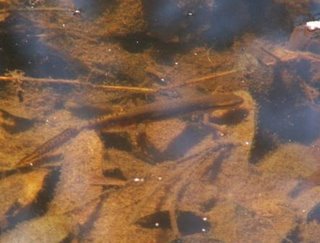
Here are a couple out of the water:
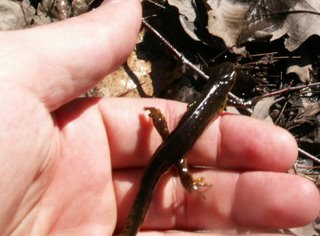
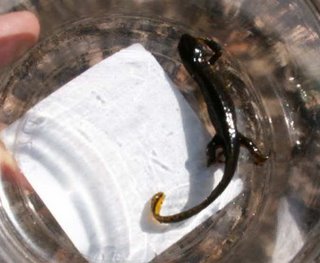
I love newts. They are pretty in their adult form (these are adults), and they are beautiful in their intermediate form, the ‘eft’ that leaves the water after its larval phase and is frequently seen marching around in wet weather. The red-spotted newt’s efts are bright orange with those same red spots that the adults have. Newts are poisonous. Few creatures eat them, and they move with the slow, steady confidence of an animal that does not have to worry about being attacked. These were a piece of cake to pluck out of the water.
I also found some redback salamanders (Plethodon cinereus). Here’s a pair as I found them under a rock:

Here’s another trying with all its might to burrow through my hand:

After we felt we had sufficiently cased the mountain bog and pond, we headed on to some promising timber rattler habitat. After hiking for a few miles we made the decision to cut south and find some boulder fields and outcroppings. The decision to head downhill was based on a combination of impatience and my reading of my topographical map of the area (a Christmas gift from Susan Walker and Fernando Ornelas). I guess we guessed right, because soon we hit the edge. The gently sloping forest floor fell away into a steep slope of tumbled rocks and two-story outcroppings jutting out from the mountainside.
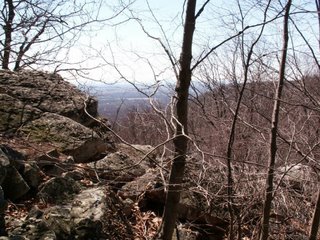
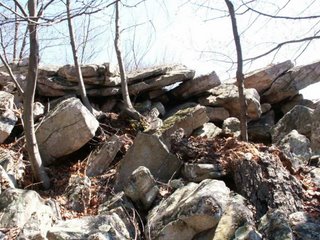
We worked our way back along this landscape, studying the slopes for snakes and peering into cracks and spaces between the rocks. We found nothing. We got a lot of exercise, but saw no snakes.
We made our way back to the car and tried a couple more spots after that. We found no snakes, but I did make a big find, for me at least.
I flipped what struck me as too small a log to house much, and I saw three redback salamanders (all the leadback phase, interestingly) and this brilliant little gem:

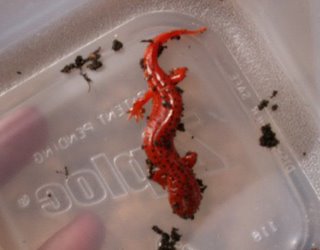
This is a red salamander (Pseudotron ruber). I had never caught one of these, and they have been on my short list of critters to find. I hope you can see why. Like the efts, they are painted a totally unnaturally bright color. They also have cartoonishly rounded features that give them an almost cuddly look. They may actually mimic the efts, gaining some protection from predators that have learned to avoid their poisonous look-alikes.
I also found a little (2 inches) slimy salamander (Plethodon glutinosis) under another log. I like how these little slimies have big, brassy spots on their backs, though the pictures did not turn out well:

Scott did some rock flipping at the bottom of the slope and found “thousands” of redback salamanders. He also flipped this itty-bitty two lined salamander (Eurycea bislineata) at the edge of a stream. In one of the cutest episodes so far this year, it tried to bite his hand:
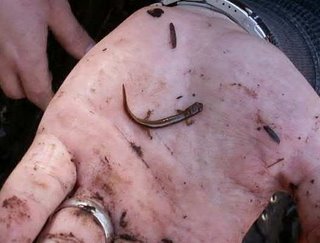
Conditions were sunny and in the low 60s.
Totals:
Red spotted newts: 15+
Redback salamanders: 12+
Slimy salamanders: 1
Two-lined salamanders: 1
Red salamander: 1
Spotted salamander eggs: five or so egg masses
Wood frog eggs: absolutely mind blowing
No comments:
Post a Comment